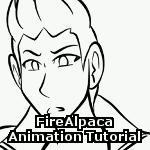
There are also a few Discords where you can ask question and maybe get into more real time discussions. If you can, find some live streams of people using OT on YouTube or Twitch. With this in mind, try and watch some YouTube videos and see if it starts to make sense and how other animators work in OT. Column 3 could be a level with different mouth shapes for when you lipsync dialogue. Column 2 could be a level with eyes in various states of expressions, opening and closing. You can stack multiple columns (timeline:bottom->top, xsheet:left->right) of different level frames to form your scene frame.Įxample of a head: Column 1 could be a level with just the head, hair and maybe nose drawings. Typically you would use 1 Level in 1 Column.Īdditionally think of columns as Layers like in Firealpaca or other drawing software. The exposed frames in the column are what gets rendered to your final animation. The frames on the xsheet/timeline are the Scene Frames.


These are Level Frames.Ī column on the xsheet/timeline is used to expose those drawings/level frames in the order that you want and for how long you want. In OT, Levels are a collection of drawings, typically the same object but drawn in different poses, orientations, positions, etc.


 0 kommentar(er)
0 kommentar(er)
